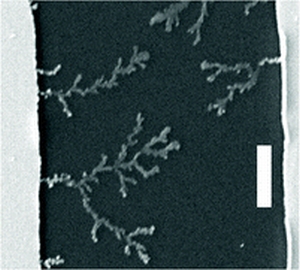The growth velocity of platinum nanowires in an aqueous solution of K2PtCl4 is investigated as a function of the metal complex concentration and temperature. The solution is specially prepared to provide mainly the neutral complex cis-[PtCl2(H2O)2] for growing nanowires by dielectrophoresis. The measured growth velocities indicate diffusion-limited nanowire growth at low concentration and high temperature in qualitative agreement with a theoretical analysis that includes the diffusion of metal complexes and the dielectrophoretic force on the complexes. At concentrations greater than 100 μM and low temperature, different behavior is observed, suggesting the growth rate to be limited by the deposition reaction of platinum at the nanowire tip. The enhancement of the K+ concentration is found to support nanowire growth. Possible reasons for a rate limitation and for the difference between observed and calculated nanowire growth velocities are discussed.

The growth velocity of platinum nanowires in an aqueous solution of K2PtCl4 is investigated as a function of the metal complex concentration and temperature. The solution is specially prepared to provide mainly the neutral complex cis-[PtCl2(H2O)2] for growing nanowires by dielectrophoresis. The measured growth velocities indicate diffusion-limited nanowire growth at low concentration and high temperature in qualitative agreement with a theoretical analysis that includes the diffusion of metal complexes and the dielectrophoretic force on the complexes. At concentrations greater than 100 μM and low temperature, different behavior is observed, suggesting the growth rate to be limited by the deposition reaction of platinum at the nanowire tip. The enhancement of the K+ concentration is found to support nanowire growth. Possible reasons for a rate limitation and for the difference between observed and calculated nanowire growth velocities are discussed.
